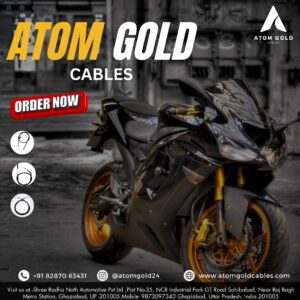Control cables are essential for your bike’s performance, transmitting power from the levers to critical systems like brakes and gears. Over time, bike control cable replacement signs such as reduced responsiveness, visible fraying, or rust may appear, indicating the need for maintenance to ensure safety and smooth operation. In this guide, we’ll explore these signs in detail and provide tips for maintaining your bike’s control cables.

What Are Control Cables and Their Role in Bikes?
Control cables are the lifeline of your bike’s mechanical systems. They typically consist of a steel wire encased in a protective housing and are used in systems like:
- Brake Cables: Ensure precise braking by transferring force from the brake lever to the brake mechanism.
- Gear Cables: Facilitate smooth shifting by transmitting movement from the shifter to the derailleur.
Properly functioning cables are vital for performance and safety, making it important to identify early signs of wear or failure.
Signs Your Bike’s Control Cable Needs Replacement
1. Reduced Responsiveness:
One of the first signs of a failing control cable is reduced responsiveness in brakes or gear shifts. You might notice:
- A delay in braking action when pulling the lever.
- Difficulty in shifting gears or gears slipping unexpectedly.
This issue often occurs due to cable stretch or fraying, which reduces the efficiency of force transmission.
2. Visible Fraying or Damage:
Inspect your cables for visible signs of wear, such as:
- Frayed or broken steel wires.
- Cracks or tears in the cable housing.
- Rust or corrosion on the cable surface.
Frayed cables are a significant safety hazard, as they can snap unexpectedly, leading to brake or gear failure.
3. Sticky or Stiff Movement:
A properly functioning cable should move smoothly within its housing. If you notice stiffness or stickiness when operating the brake or gear levers, it could indicate:
- Dirt or debris buildup inside the housing.
- Corrosion affecting the cable’s surface.
- Damaged housing causing friction.
This issue not only affects performance but also increases wear on other components.
4. Inconsistent Performance:
If your bike’s performance fluctuates—such as brakes working fine one moment and feeling weak the next—it could signal a problem with the control cable. This inconsistency often arises from:
- Uneven stretching of the cable.
- Damaged housing restricting cable movement.
5. Worn-Out Cable Ends:
The cable ends, where the wire connects to the levers or mechanisms, are prone to wear and tear. Look for:
- Frayed or loose cable ends.
- Damage to the ferrules (metal caps) that secure the cable.
Damaged ends can affect the cable’s ability to stay in place, leading to unpredictable performance.
6. Rust or Corrosion:
Exposure to moisture and environmental elements can cause rust and corrosion on control cables, especially if the bike is stored outdoors. Rust not only weakens the cable but also increases friction, making operation more difficult.
7. Housing Deformation:
Inspect the cable housing for:
- Kinks or bends.
- Flattened or compressed sections.
Deformed housing restricts the smooth movement of the cable, leading to poor performance and accelerated wear.
8. Excessive Stretching:
Over time, control cables naturally stretch, reducing their tension. Signs of excessive stretching include:
- Brake levers pulling too far before engaging the brakes.
- Gears failing to shift properly or needing frequent adjustments.
9. Noise During Operation:
Unusual noises, such as squeaking or grinding when using the brakes or shifting gears, may indicate internal damage to the cable or housing.
Causes of Control Cable Wear and Damage:
Understanding the common causes of control cable wear can help you prevent issues and extend their lifespan:
- Frequent Use: Regular use leads to gradual wear and stretching.
- Exposure to Elements: Rain, mud, and dirt accelerate corrosion and degrade the housing.
- Lack of Maintenance: Neglecting routine cleaning and lubrication can cause debris buildup and increase friction.
- Improper Installation: Poorly installed cables are more prone to damage and reduced performance.
- Aging: Even with proper care, cables degrade over time due to material fatigue.
How to Replace Your Bike’s Control Cable:
Replacing a bike’s control cable is a straightforward process with the right tools and guidance. Follow these steps:
1. Gather Your Tools
You’ll need:
- Replacement control cable.
- Cable cutters.
- Hex keys or screwdrivers.
- Lubricant.
- New ferrules or housing (if required).
2. Remove the Old Cable
- Shift to the smallest gear or release brake tension to slacken the cable.
- Loosen the cable anchor bolt using a hex key or screwdriver.
- Pull the cable out of the housing and remove it completely.
3. Inspect and Replace Housing
Check the cable housing for damage. Replace it if you notice any kinks, cracks, or wear.
4. Install the New Cable
- Thread the new cable through the housing, ensuring it moves smoothly.
- Attach the cable to the anchor bolt and secure it firmly.
- Trim any excess cable using cable cutters and attach a new ferrule to the end.
5. Adjust Tension
Adjust the cable tension using the barrel adjuster or anchor bolt to ensure proper operation.
6. Test the System
Test the brakes or gears to ensure smooth and responsive operation. Make further adjustments if necessary.
Preventive Maintenance Tips for Control Cables
To extend the lifespan of your bike’s control cables, follow these maintenance tips:
- Regular Cleaning: Clean the cables and housing after rides, especially in muddy or wet conditions.
- Lubrication: Apply a light lubricant to reduce friction and prevent rust.
- Frequent Inspections: Check for signs of wear or damage and address issues promptly.
- Proper Storage: Store your bike indoors or use a cover to protect it from moisture and dirt.
- Professional Servicing: Have your bike serviced regularly by a professional to ensure all components are in good condition.
When to Consult a Professional
While replacing control cables is a manageable task for many riders, some situations require professional assistance:
- Persistent performance issues after replacement.
- Complicated cable routing, such as in internally routed frames.
- Lack of proper tools or experience.
Conclusion
Your bike’s control cables are critical for performance and safety. Recognizing the signs of wear—such as reduced responsiveness, visible damage, or inconsistent performance—can help you address issues before they lead to failure. Regular maintenance, timely replacements, and the use of high-quality cables ensure a smooth and safe riding experience. Whether you’re a casual cyclist or a serious rider, paying attention to your bike’s control cables will keep you rolling with confidence.
Find the Atom Gold difference today – where the heritage of the past is merged with the technology of the future, and quality is the standard.
For more information about our products or to place an order, visit our website or contact us at our office in Ghaziabad, UP. Let us help you drive with confidence, powered by the best accelerator cables in the industry.
Visit us at -Shree Radha Nath Automotive Pvt Ltd , Plot No-35, NCR Industrial Park GT Road Sahibabad, Near Raj Bagh Metro Station, Ghaziabad, UP -201005. Mobile- 9873097340, 82870 63431 Ghaziabad, Uttar Pradesh, India 201005
